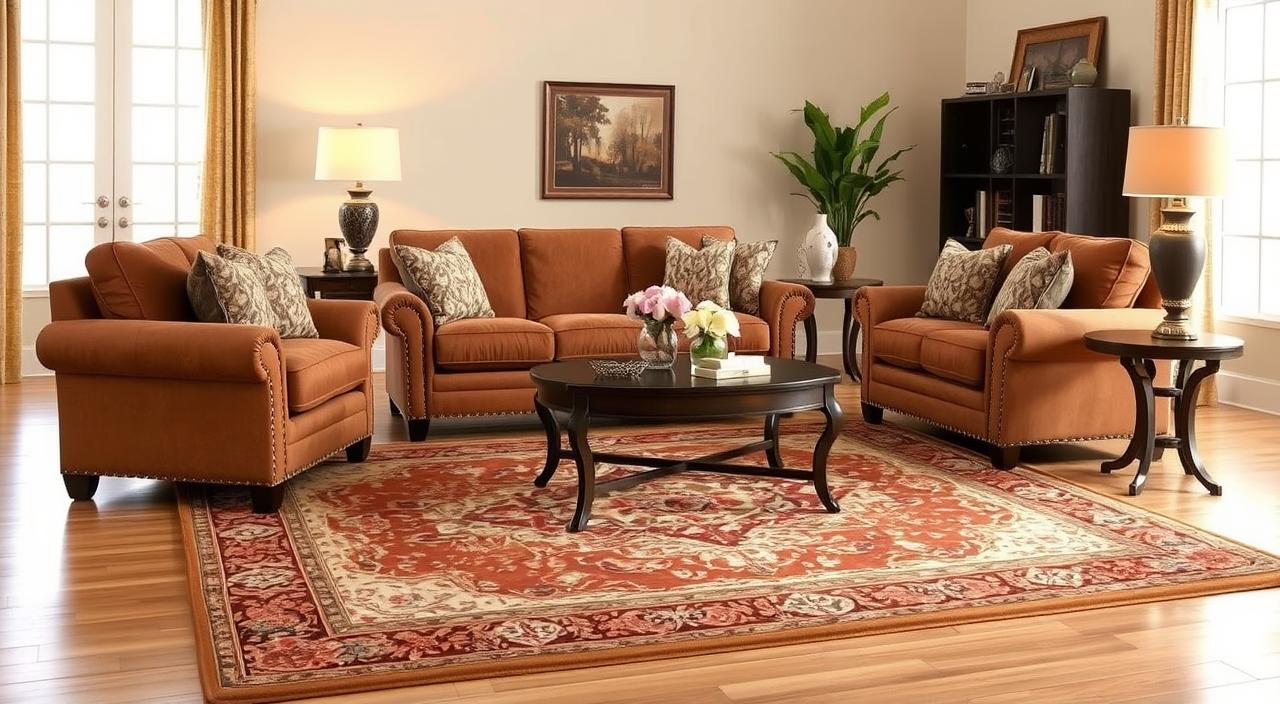Welcome to the world of furniture making. Here, creativity and craftsmanship blend to create lasting pieces. You’ll start a journey to learn the secrets of furniture mastery. You’ll understand the evolution of modern furniture making and master basic woodworking techniques.
Furniture making is an art that needs patience, skill, and detail. You’ll focus on creating custom furniture that’s sustainable. You’ll learn to make your home unique with handcrafted, high-quality pieces that show your style.
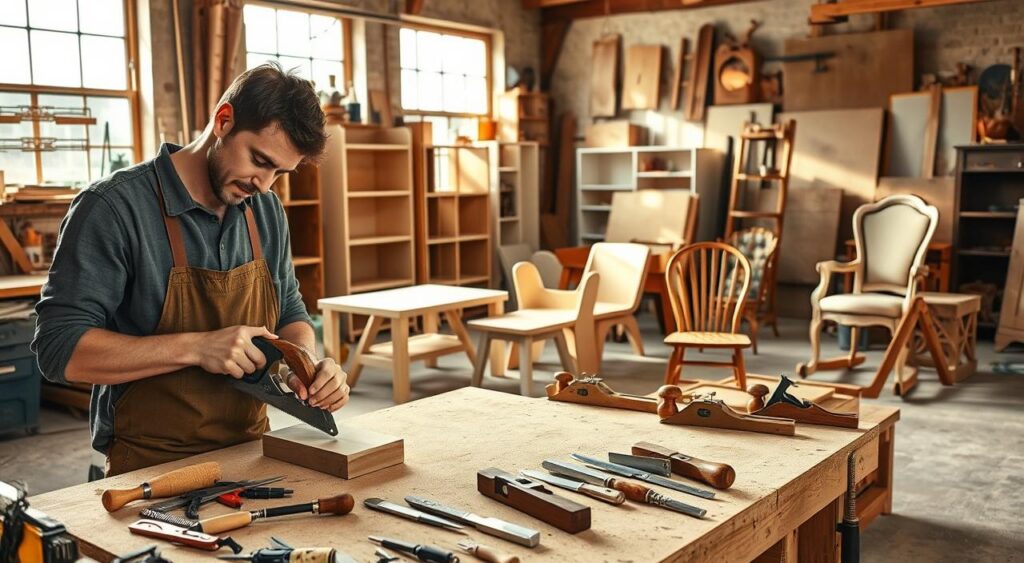
Introduction to Furniture Mastery
In this article, you’ll learn the basics of furniture making. You’ll discover the different materials used, like wood, metal, and more. You’ll also find out about the tools needed and how to use them to make unique furniture.
Key Takeaways
- You will learn the fundamentals of furniture making and woodworking.
- Understanding the evolution of modern furniture making is crucial for creating unique pieces.
- Custom furniture creation and sustainability are key aspects of furniture mastery.
- Woodworking techniques and tools are essential for creating handcrafted pieces.
- Furniture making requires patience, skill, and attention to detail.
- You will discover how to transform your home with high-quality, handcrafted furniture.
The Evolution of Modern Furniture Making
Exploring furniture making reveals the evolution of modern techniques. These new methods blend with old ones, creating unique, functional pieces. Now, thanks to technology, making your own Home Decor is easier than ever.
Old techniques like woodworking and upholstery meet new ones like 3D printing. This mix brings innovative, sustainable furniture to life. It meets the diverse tastes of today’s consumers.
Traditional vs Contemporary Techniques
Hand-carving and joinery are still prized for their craftsmanship. Yet, modern methods offer speed, precision, and savings. By mixing these, makers craft pieces that are both useful and beautiful.
The Rise of Custom Furniture Creation
Custom Furniture is now more popular than ever. People want spaces that show their personality. Thanks to tech, makers can design and make unique pieces that fit specific needs.
This focus on customization makes Home Decor more personal. It lets people show off their style and creativity.
| Technique | Traditional | Contemporary |
|---|---|---|
| Woodworking | Hand-carving, joinery | 3D printing, CNC machining |
| Upholstery | Hand-stitching, traditional fabrics | Computer-aided design, sustainable materials |
When you dive into furniture making, remember to mix old and new techniques. This blend helps you create Custom Furniture that shows your style. It also supports a greener Home Decor approach.
Essential Tools for Your Furniture Making Journey
Starting your furniture making journey means you need the right Woodworking Tools and equipment. A well-stocked workshop is key to making high-quality furniture. The right Furniture Making Equipment can greatly improve your work.
Basic hand tools like chisels and saws are important. So are power tools like table saws and drill presses. Having the right tools is crucial.
Setting up your workshop right is important. You’ll need safety gear like gloves and goggles. Also, good storage helps keep your tools organized and easy to find. A tidy workshop saves time and reduces stress, letting you focus on your craft.
Some essential Woodworking Tools include:
- Table saws for precise cuts
- Drill presses for accurate holes
- Sandpaper and blocks for smooth surfaces
- Clamps for holding pieces while gluing
Investing in the right Furniture Making Equipment and Workshop Essentials will help you make beautiful furniture. Always follow safety rules and use your tools wisely for a safe and fun experience.
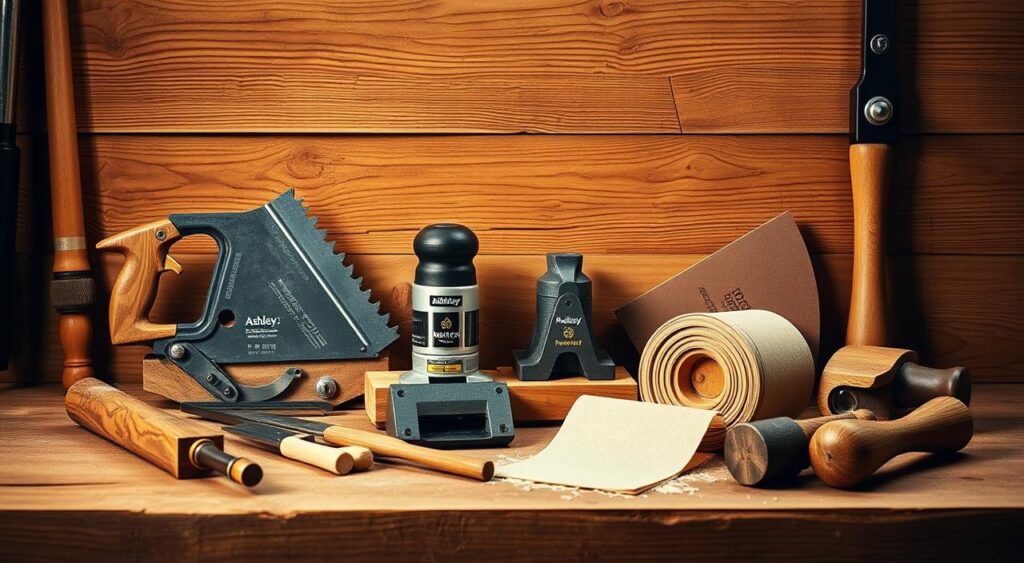
Understanding Different Types of Furniture Materials
Choosing the right material for furniture is key. You want something that’s both strong and looks good. There are many types of materials, each with its own benefits. We’ll look at Sustainable Wood, Eco-Friendly Options, and more.
You can pick from hardwoods, softwoods, and metals. Hardwoods like oak are strong and beautiful. Softwoods like pine are cheaper and versatile. Metals add a modern touch to your furniture.
Hardwoods vs Softwoods
Hardwoods and softwoods are two main wood types. Hardwoods are denser and last longer. Softwoods are less dense and get scratches easily. But they’re cheaper and good for many furniture pieces.
Metal Components and Applications
Metal is great for many furniture types, from sofas to tables. It’s versatile and can be shaped into unique designs. It’s also durable and easy to care for, perfect for outdoor use.
Alternative Materials and Sustainability
Nowadays, people are choosing eco-friendly materials for furniture. Sustainable Wood, bamboo, and recycled plastic are popular. They’re good for the planet and stylish, making them a great choice.
Choosing the right materials makes furniture beautiful, durable, and green. You can pick from traditional woods or modern metals. Exploring Sustainable Wood and Eco-Friendly Options is a smart choice for stylish, green furniture.
| Material | Characteristics | Benefits |
|---|---|---|
| Hardwoods | Dense, durable, and strong | Long-lasting, resistant to scratches and dents |
| Softwoods | Less dense, prone to scratches and dents | Affordable, versatile, and easy to work with |
| Metal | Durable, low maintenance, and versatile | Modern and industrial chic, ideal for outdoor furniture |
| Sustainable Wood | Environmentally friendly, durable, and stylish | Eco-friendly, sustainable, and perfect for creating unique furniture pieces |
Mastering Basic Furniture Construction Techniques
Starting your journey in furniture making means learning key techniques. These are the building blocks of Furniture Construction. You’ll learn how to measure, cut, assemble, and finish pieces. Understanding these steps is crucial for making sturdy, useful furniture.
Grasping Woodworking Techniques is also important. This includes mastering Joinery Methods. These methods help you create strong, lasting joints in your furniture.
First, get to know the basic tools and materials for furniture making. Learn about different types of wood and how to work with them. You’ll also discover various Joinery Methods, like mortise and tenon, dovetail, and dado joints. These are key for making strong, functional furniture.
Some essential techniques to learn in Furniture Construction are:
- Measuring and cutting accurately
- Assembling and gluing joints
- Finishing and sanding surfaces
- Applying Woodworking Techniques to create unique designs
By mastering these basic techniques, you’ll be on your way to making beautiful, lasting furniture. Understanding Furniture Construction, Woodworking Techniques, and Joinery Methods will help you create pieces that will stand the test of time.
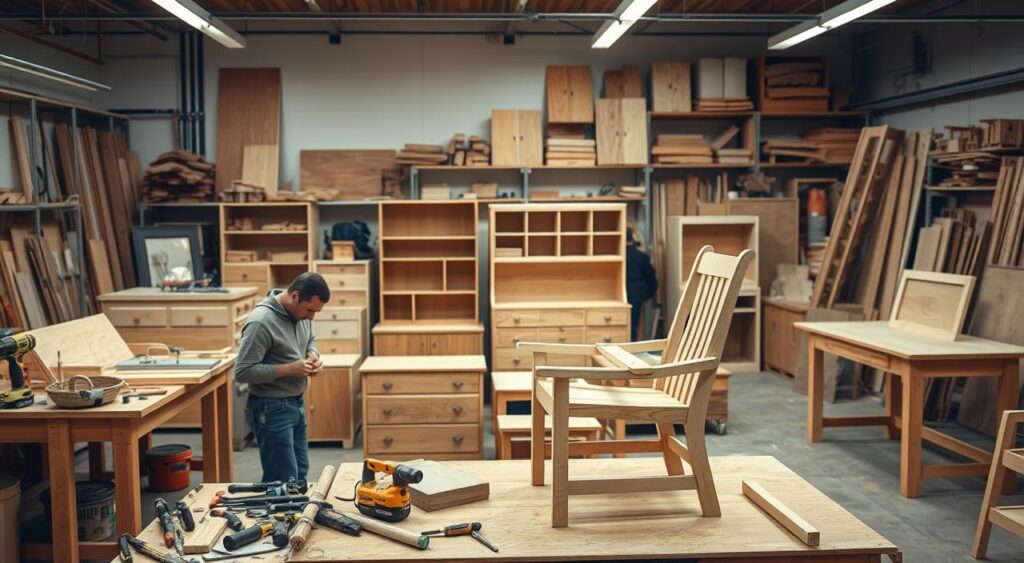
The Art of Professional Furniture Design
Exploring furniture making means learning about professional design. It’s about finding the right mix of looks and use. You must think about who will use it, where it will go, and how it will look. Good design needs a solid grasp of design basics, elements, and how to use space.
Interior Design is key in furniture making. It helps make spaces that look good and work well. Think about what the room is for, how it’s laid out, and how people move through it. This way, you can make a design that improves the user’s experience. Space Planning is also important. It’s about making the most of the space you have to create a place that’s both useful and cozy.
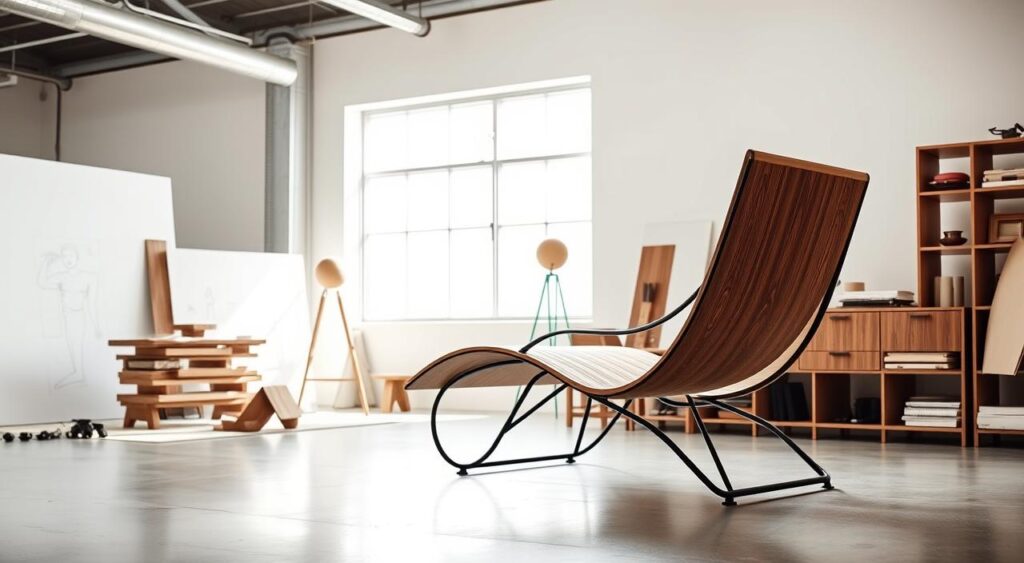
- Design principles, such as balance, proportion, and emphasis
- Design elements, such as line, shape, and texture
- Space planning, including the placement of furniture and the flow of traffic
By getting good at these areas, you can make furniture that looks great and works well. It will make any space better and show off your style.
Remember, professional furniture design takes time, creativity, and care. Use your furniture making skills with Interior Design and Space Planning knowledge. This way, you can make pieces that are both unique and useful. They will bring happiness and comfort to those who use them.
Common Mistakes in DIY Furniture Projects
Working on DIY furniture can be thrilling. But, inaccurate measurements can cause big problems. Always double-check your measurements before cutting wood. DIY furniture making needs careful attention, especially with poor joinery.
Practice your joinery skills and use woodworking guides or jigs for precise joints. This will help you avoid mistakes.
Plan ahead and take your time to avoid common Furniture Making Mistakes. Woodworking Errors can be tough, but they’re also chances to learn. Here are some mistakes to watch out for in DIY furniture making:
- Inaccurate measurements
- Poor joinery
- Inadequate finishing
Knowing these potential DIY Furniture pitfalls helps you avoid them. This way, you can make beautiful, useful pieces for your home. Always follow safety rules and use the right woodworking techniques for a successful project.
Conclusion: Your Path to Furniture Making Excellence
As you finish your journey to furniture making mastery, remember the importance of practice, patience, and persistence. You now have the knowledge and skills to start your own woodworking journey. You can create unique, functional pieces that show off your personal style and make your home better.
Whether you’re experienced in custom furniture or just starting, furniture making is full of possibilities. It lets you express your creativity in many ways.
Don’t be afraid to face challenges and learn from your mistakes. Every piece you make is a chance to grow and improve. Keep trying new things, stay curious, and always keep learning.
By improving your skills and sharing your vision, you’ll find true joy in making beautiful, unique furniture. Let your love for furniture making lead the way and let your creativity fly. Enjoy the journey, celebrate your successes, and inspire others with your amazing creations. Your journey to furniture making excellence is just starting!
FAQ
What are the key differences between traditional and contemporary furniture making techniques?
Traditional furniture making uses manual skills like woodworking and upholstery. Modern methods use tech like 3D printing and computer design. Knowing both can help you mix old skills with new tech.
How can I create custom furniture that reflects my personal style?
Custom furniture lets you make pieces that fit your needs and taste. By learning about design, space planning, and drawing, you can make furniture that matches your style perfectly.
What are the essential tools and equipment I need to start my furniture making journey?
Having a good workshop is key for making furniture. You’ll need basic hand tools and power tools. The right tools and safety gear will help you tackle many projects confidently.
How do I choose the right materials for my furniture projects?
The materials you choose affect your furniture’s look, feel, and how long it lasts. Learning about different materials like wood, metal, and bamboo can help you pick the best for your projects.
What are the fundamental techniques for constructing furniture?
Learning basic skills like joinery, measuring, and assembling is crucial. These skills help you make furniture that lasts. They’re the base for more complex projects.
How can I avoid common mistakes in DIY furniture projects?
Even pros make mistakes. Knowing common errors like bad measurements and poor finishing can help you fix them. This ensures your DIY projects turn out right.

